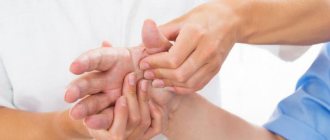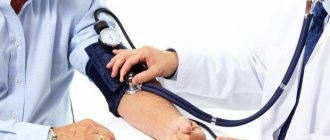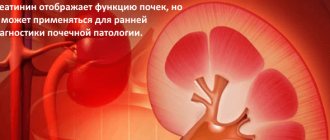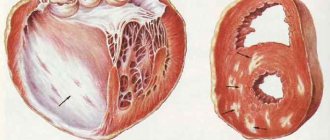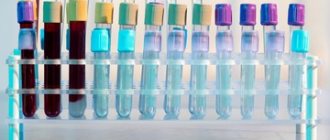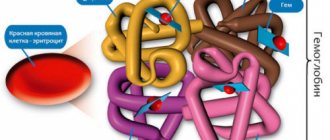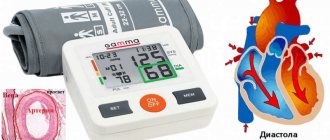What is creatinine and the process of formation
Creatinine (creatine) is a special metabolic product of biochemical reactions of energy metabolism in the body. It is produced from creatine molecules, which is important in the nutritional process, energy stimulation and muscle tone.
Only 2% is converted into creatine, formed in the muscles. The rest enters the bloodstream, being transported to the kidneys, where filtration occurs to form urine. After which the metabolite is disposed of through the bladder with urine. Therefore, its content in the blood indicates the functioning of the kidneys.
Based on the level of creatine, preliminary diseases of the urinary and muscular systems can be determined.
Analysis options
In addition to standard blood and urine tests for creatinine, additional tests may be needed. The Rehberg test is a way to determine urine filtration, its reabsorption and the efficiency of renal circulation. It is used to identify damage to kidney tissue and the degree of insufficiency of their function.
In the morning after sleep, the patient drinks 300 ml of clean water and empties the bladder. Exactly one hour later, you should urinate into the first urine collection container and label it, and after 2 hours, into the second. In the interval between urinations, blood is taken from a vein.
Less commonly, daily urine collection is used for testing.
The level of creatinine can determine the loss of protein in the urine (proteinuria). In this case, it is enough to take a single (morning) portion of urine and calculate the ratio of albumin to creatinine. This technique is quite informative, easy to carry out, and is used for kidney diseases, assessing the risk of hypertensive and diabetic nephropathy.
Normal blood creatinine levels in men, women and children (table)
The normal level of creatine in serum depends on various indicators:
- age - it does not change for many years. Only in the body of a mature person after 60 years is there a change in creatine production;
- gender - due to the physiological characteristics of men, increased effort in work and addiction to physical activity;
- a lean or athletic build (volume of muscle mass);
- dietary preference;
- renal failure - the creatinine norm for those living with one kidney differs from the usual results, since the permissible creatinine level is lower than that of the average person, since one kidney functions for both.
Based on the above criteria, the norm of indicators is within the following limits:
| Floor | Age, years | Normal creatinine | |
| µmol/l | mg/dl | ||
| Newborns | At the moment of birth | 27,0-88,0 | 0,3-1,0 |
| Children | up to 1 year | 18,0-35,0 | 0,2-0,4 |
| 1-10 years | 27,0-62,0 | 0,3-0,7 | |
| Boys and girls | 10-18 years | 44,0-88,0 | 0,5-1,0 |
| Men | 18-60 | 80,0-115,0 | 0,5-1,1 |
| 60 and > | 71,0-115,0 | 0,4-1,1 | |
| Women | 18-60 | 53,0-97,0 | 0,7-1,4 |
| 60 and > | 53,0-106,0 | 0,7-1,5 | |
In persons suffering from renal failure, the upper limit of indicators is 135 µmol/l. When it increases, serious renal dysfunction is diagnosed. When the norm deviates upward by 500 µmol/l, the patient should be immediately connected to dialysis (artificial kidney machine). In such a situation, an organ transplant may be required.
Norm of creatinine in urine in adults and children (table)
The creatine content in urine plays a significant role in diagnosing the disease. In laboratory studies, its indicator is important at the time of assessing the functional abilities of the renal structures.
The norm of creatinine varies greatly among people of different genders and ages:
| Gender, age | Norm, µmol/l |
| Children under 1 year | 71-177 |
| Children 1-12 years old | 71-194 |
| Boys and girls 12-18 years old | 71-265 |
| Women over 18 years old | 97-177 |
| Men over 18 years old | 124-230 |
For the most accurate diagnosis, experts advise doing parallel tests of creatine in urine and blood. A special role is played by the ratio of creatinine content in urine and plasma. Urine analysis is collected over 24 hours (during the day) with the required volume of 20 ml.
Symptoms
Creatinine is a slightly toxic compound . Its slight increase in urine usually does not cause any symptoms. But in case of renal pathologies, diseases of other internal organs, the concentration of this substance can exceed the standard by 10 times or more. In this case, the patient begins to complain about the appearance of the following characteristic signs:
- Headache.
- Pain syndrome in the kidney area.
- Fast fatiguability.
- Reduced urine production.
- Cramps.
- Unpleasant taste in the mouth.
- Dyspnea.
- Renal edema.
- Unstable blood pressure.
Interpretation of biochemical analysis for creatinine
Biochemical analysis for creatinine is a method for diagnosing a substance contained in the serum of the human body and is a decay process. If it increases, poisoning occurs. The creatine level reflects the state of the body.
By taking a creatinine test, you can understand how the kidneys work. To do this, use the glomerular filtration rate (GFR), which determines the performance of the renal system.
GFR shows how well the body eliminates toxins and what condition the kidneys are in. To calculate this indicator, you need to know creatine and specify race, age and gender.
Deciphering biochemical analysis plays a major role in establishing a diagnosis. With proper diagnosis, serious complications and consequences for the patient can be avoided in time.
In medicine, there is a special form for entering deciphered analysis indicators. A qualified specialist compares the data with the norms and determines the presence of possible or existing diseases in the patient.
Increased and decreased creatinine, causes and symptoms
The reason for changes in creatine levels is impaired kidney function - increased synthesis or decreased utilization of this substance from the body. It is worth understanding how long ago the changes in the functional activity of the kidneys occurred.
Most often, the manifestation of renal failure is observed with increased load and is accompanied by heaviness and pain in the lumbar region.
Characteristic symptoms of increased creatinine are:
- exhaustion;
- general fatigue;
- difficulty breathing;
- confusion and lack of clarity in consciousness.
In this case, it is necessary to conduct laboratory tests, taking tests for creatine content in plasma and urine. The result will allow you to understand how the kidneys work, regardless of the physical difficulty of following a diet.
If the indicator is deviated from the norm, this indicates ineffective kidney function or kidney damage. In case of damage, an inflammatory-infectious process, a state of shock, cancer, or impaired blood flow may begin.
An increase in the indicator may begin due to:
- disturbances in urine discharge if urolithiasis;
- heart failure;
- dehydration;
- severe blood loss;
- pathological changes in muscle structure (gigantism, muscle dystrophy, acromegaly, myasthenia and others);
- long-term use of certain toxic medications (barbiturates, sulfonamides, antibiotics);
- radiation sickness;
- thyrotoxicosis.
There are cases of false elevations when taking medications that contain high levels of ibuprofen, vitamin C, cephalosporin, or levodopa.
Also, the analysis may be reduced during the period:
- vegetarianism;
- prolonged fasting, followed by weight loss;
- taking corticosteroid medications;
- gestation, especially the 1st and 2nd trimesters;
- dystrophy of muscle structure;
- severe liver diseases;
- protein-free diet;
- cancer;
- urinary tract blockages.
What does deviation from the norm mean?
The analysis results often reveal deviations from acceptable indicators - excess or underestimation. The substance depends directly on diet and stress, pathologies and acute conditions of the body. Let's look at what each research result means.
High level
An elevated creatinine level indicates a failure of filtration by the renal system. But decoding can only be done by a doctor who evaluates not only the indicators of the substance, but also other symptoms not related to the kidneys. Often high creatinine occurs when there is only one kidney due to surgery or a developmental abnormality.
More on the topic: What are the reasons for a decrease in the amount of urine?
Exceeding the norm may mean one of the following factors:
- Consumption of high-protein foods, active training for muscle growth, pregnancy, breastfeeding or dehydration;
- Fractures, injuries, internal bleeding, burns;
- A course of treatment with certain drugs - Captopril, Cimetidine, Cyclosporine. There are also creatine supplements that affect test results;
- Metabolic diseases - gout or diabetes;
- Diseases of the endocrine system, gigantism, hyperthyroidism, hypercortisolism or acromegaly;
- Cancer or kidney failure, urolithiasis and other pathologies of the urinary system.
Low level
Low concentrations are detected very rarely, and the phenomenon is not associated with kidney problems. creatinine is underestimated in the following cases:
- vegetarianism with a lack of protein or insufficient consumption, fasting and exhaustion of the body;
- muscular dystrophy, loss of muscle mass;
- chronic liver diseases;
- taking corticosteroids;
- toxicosis during early pregnancy;
- increased thyroid function;
- for anemia and leukemia.
Clearance below acceptable standards occurs with heart or kidney failure, problems with blood flow in the kidneys, or rhabdomyolysis. An important indicator during the examination is urea, the end product of protein metabolism. When urea (carbamide) decreases, the most common cause is a malfunction of the renal glomeruli.
How to lower or raise creatinine levels
If the indicator changes above the norm, it is necessary to find and eliminate the cause of the increase in creatine. This substance significantly affects the functioning of the kidneys and is a serious disorder in the human body.
The only exceptions may be active work activity or the influence of medications on the analysis, as well as some dietary habits. Therefore, the patient needs to visit a qualified specialist to clarify the diagnosis.
Having identified the causes, the extent of the violation and received an appointment, you should follow the doctor’s recommendations and follow the instructions.
In a situation where there has been a decrease in creatinine, achieving a normal level is possible by following proper nutrition and certain recommendations from a specialist.
When is it necessary to check?
The doctor, when examining the patient and collecting anamnesis, will definitely write out a referral for a biochemical examination, including a urine test for creatinine, if the latter complains:
- for pulling, cutting or sharp pain in the lower back;
- feeling of insufficient emptying of the bladder;
- frequent urge to urinate, including false ones;
- the presence of purulent, mucous or bloody impurities in the urine;
- discomfort when urinating, accompanied by burning and pain;
- severe swelling of the face, lower (legs) and upper extremities.
Swelling of the legs is a good reason to undergo a biochemical urine test
In addition to primary diagnosis, by studying creatinine levels, the functional characteristics of the organs of the urinary system are assessed in multiple pathological conditions, which include the following. Acute and chronic kidney diseases - glomerulonephritis (inflammation of the renal glomeruli) and pyelonephritis (inflammation of the renal pelvis) in many cases become the cause of renal failure, which can develop even to the stage of decompensation.
To regularly monitor the filtration work of the kidneys, patients periodically determine their creatinine level. In these pathologies, it is reduced. Metabolic pathologies - diseases caused by its disruption, require constant monitoring and the creation of normal conditions for kidney activity. Thus, with diabetes mellitus, dysfunction of the thyroid gland (hypo- and hyperthyroidism), adrenal glands and pituitary gland, creatinine values may go beyond the limits of indicators accepted as normal.
An acute form of inflammatory and infectious diseases - excessive intoxication leads to problems with filtration in the renal glomeruli, which will cause an increase in creatinine. This category includes diseases of a bacterial and viral nature. Drug therapy with drugs that can affect the condition of the urinary system. The content of this metabolite is checked to assess the performance of the kidneys and minimize the risks of reduced filtration supply.
Autoimmune pathologies such as lupus erythematosus (structural damage to connective tissue) and vasculitis (destruction of the walls of blood vessels). Arterial hypertension - increased pressure can lead to a pathological shift in creatinine parameters. Oncological neoplasms, both benign and malignant, in some cases influence the content of this substance.
Checking the concentration of creatinine in urine is also carried out for preventive purposes:
- patients who have suffered acute forms of diseases of the urinary system, in particular the kidneys;
- as a screening examination before and after surgical operations in the genitourinary area;
- monitoring the course of pregnancy complicated by various manifestations of insufficient renal function;
- people with a genetic predisposition to pathologies of the urinary system;
- obtaining a comprehensive assessment of the functioning of the urinary internal organs.
Reference! Daily urine, due to its approximately constant creatinine content, can be used for other diagnostic techniques, for example, hormonal tests.
Diet recommendations for high creatinine levels
Proper nutrition during the period when the indicator deviates from the norm plays an important role. Many foods are excessive sources of creatine (meat, coffee, strong tea, whole milk, alcohol). If the level is elevated and there are pathological changes in the kidneys, you should adhere to diet 7A or 7B, excluding from the diet:
- fatty fish and meats;
- whole milk;
- caffeinated drinks;
- baked goods;
- fried foods;
- smoked meats;
- spices;
- foods high in salt.
Some protein (no more than 70 g per day) and animal products (no more than 23 g per day) products should simply be limited:
- lean meats;
- lean fish;
- egg (up to 3 pieces per week);
- sweet and flour products.
In cases where the indicator is very high, foods containing sugar and salt should be completely excluded from the diet. An important role is played by the method of preparing food without adding oil by:
- extinguishing;
- languor;
- baking;
- cooking;
- for a couple.
You should know that food prepared in the form of puree soups, finely chopped and liquid, is easier to digest and does not have a negative effect.
Risks and contraindications
Negative phenomena may occur during testing:
- Formation of a hematoma after blood sampling (traxevasin ointment, traxerutin can be used).
- Swelling as a result of the injection is phlebitis (a warm compress for 3 days will help).
- Bleeding occurs when there is a bleeding disorder and when certain medications are taken (aspirin, thromboass, clexane).
The only contraindication to taking a urine test for this indicator in women is monthly uterine bleeding during the period of urine collection.

